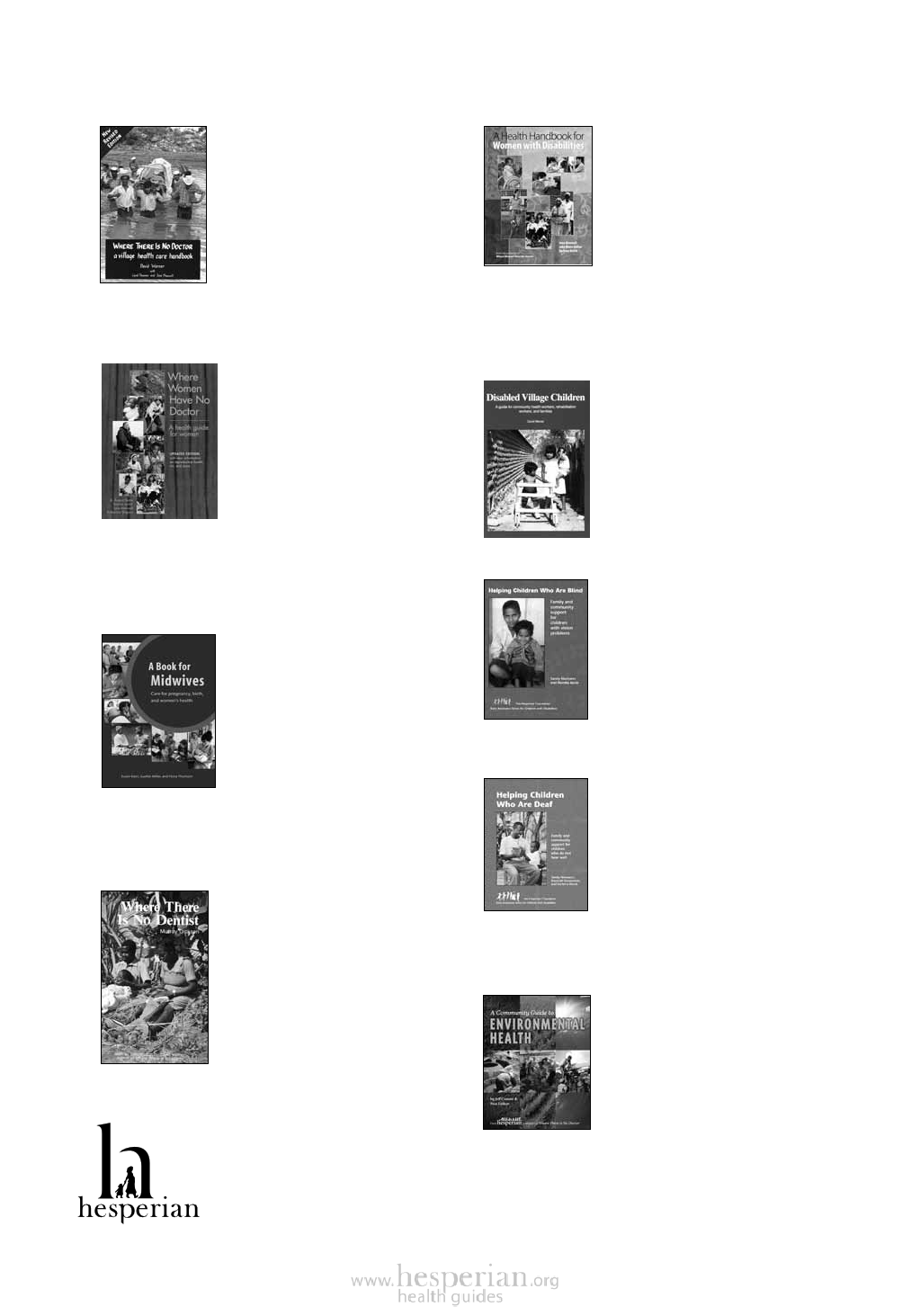
OTHER BOOKS FROM HESPERIAN HEALTH GUIDES
Where There Is No Doctor, by
David Werner with Carol
Thuman and Jane Maxwell, the
most widely used health care
manual in the world, provides
vital, easy-to-understand
information on how to diagnose,
treat, and prevent common
diseases. An emphasis is placed
on prevention, including cleanliness, diet,
vaccinations, and the importance of community
mobilization. 512 pages.
Where Women Have No
Doctor, by A. August Burns,
Ronnie Lovich, Jane Maxwell,
and Katharine Shapiro,
combines self-help medical
information with an
understanding of the ways
poverty, discrimination, and
cultural beliefs limit women’s
health and access to care. Clearly written and
with over 1,000 drawings, this book is an
essential resource on the problems that affect
only women, or that affect women differently
from men. 584 pages.
A Book for Midwives, by
Susan Klein, Suellen Miller, and
Fiona Thomson, is an invaluable
training tool and practical
reference for midwives and
anyone concerned about care
for women in pregnancy, birth,
and beyond. Discusses
preventing, managing, and
treating obstetric complications, covers HIV in
pregnancy, birth, and breastfeeding, and has
expanded information on reproductive health care.
544 pages.
Where There Is No Dentist, by
Murray Dickson, shows how to
care for teeth and gums at
home, and in community and
school settings. Detailed and
illustrated information on dental
equipment, placing fillings and
pulling teeth, teaching hygiene
and nutrition, and HIV and oral
health. 208 pages.
health guides
Visit our website for all books and
resources: www.hesperian.org
1919 Addison Street #304
Berkeley, California 94704 USA
tel: 1-510-845-4507
fax: 1-510-845-0539
bookorders@hesperian.org
A Health Handbook for
Women with Disabilities, by
Jane Maxwell, Julia Watts
Belser, and Darlena David,
provides women with disabilities
and their caregivers suggestions
on disability-friendly health care,
caring for daily needs, having
healthy and safe sexual relationships, family
planning, pregnancy and childbirth, and defense
against violence and abuse. The book also
focuses on social stigma and discrimination.
406 pages.
Disabled Village Children, by
David Werner, covers most
common disabilities of children.
It gives suggestions for
rehabilitation and explains how
to make a variety of low-cost
aids. Emphasis is placed on how
to help disabled children find a
role and be accepted in the
community. 672 pages.
Helping Children Who Are
Blind, by Sandy Niemann and
Namita Jacob, aids parents and
other caregivers in helping blind
children from birth through age 5
develop all their capabilities.
Topics include: assessing how
much a child can see, preventing
blindness, moving around safely, teaching
common activities, and many others. 192 pages.
Helping Children Who Are
Deaf, by Darlena David, Devorah
Greenstein, and Sandy Niemann,
aids parents, teachers, and other
caregivers in helping deaf
children learn basic
communication skills and a full
language. It includes simple
methods to assess hearing loss and develop
listening skills, and explores how communities
can work to help deaf children. 250 pages.
A Community Guide to
Environmental Health, by Jeff
Conant and Pam Fadem, will
help urban and rural health
promoters, activists, and
community leaders take charge
of their environmental health.
23 chapters address topics from
toilets to toxics, watershed management to waste
management, and agriculture to air pollution.
Includes activities, how-to instructions to make
health technologies, and dozens of stories.
600 pages.